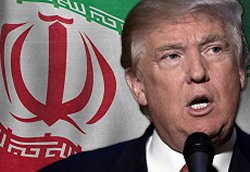
|
- Iran: Eight Prisoners Hanged on Drug Charges
- Daughter of late Iranian president jailed for ‘spreading lies’ - IRAN: Annual report on the death penalty 2016 - Taheri Facing the Death Penalty Again - Dedicated team seeking return of missing agent in Iran - Iran Arrests 2, Seizes Bibles During Catholic Crackdown
- Trump to welcome Netanyahu as Palestinians fear U.S. shift
- Details of Iran nuclear deal still secret as US-Tehran relations unravel - Will Trump's Next Iran Sanctions Target China's Banks? - Don’t ‘tear up’ the Iran deal. Let it fail on its own. - Iran Has Changed, But For The Worse - Iran nuclear deal ‘on life support,’ Priebus says
- Female Activist Criticizes Rouhani’s Failure to Protect Citizens
- Iran’s 1st female bodybuilder tells her story - Iranian lady becomes a Dollar Millionaire on Valentine’s Day - Two women arrested after being filmed riding motorbike in Iran - 43,000 Cases of Child Marriage in Iran - Woman Investigating Clinton Foundation Child Trafficking KILLED!
- Senior Senators, ex-US officials urge firm policy on Iran
- In backing Syria's Assad, Russia looks to outdo Iran - Six out of 10 People in France ‘Don’t Feel Safe Anywhere’ - The liberal narrative is in denial about Iran - Netanyahu urges Putin to block Iranian power corridor - Iran Poses ‘Greatest Long Term Threat’ To Mid-East Security |
Thursday 14 July 2011Iran’s Central Bank Under Fire
Iran’s Central Bank faces criticism on July 13 surrounding two separate announcements regarding the nation’s fiscal situation and policy. The first announcement, made by Yahya Al-Ishaq, head of Tehran’s Chamber of Commerce, was the declaration that the central bank would not be releasing any statistical information on Iran’s economy for the previous month for the first time in decades. The second surprise announcement by the Central Bank consisted of a statement of intention to knock four zeros off of Iran’s rial to combat inflation. In late June, a statement from the International Monetary Fund heralded good news for Iran’s decaying economy: the extremely controversial subsidy reform plan pioneered by president Mahmoud Ahmadinejad has reduced energy waste, bolstered the spending power of lower income families, and promoted economic equity, according to the data given by Iran’s government to the IMF. However, this brief moment of celebration over Iran’s economy—again, based on the claims of Iran’s government rather than rigorous independent analysis—is once more overshadowed by the threat of inflation. In a meeting between Central Bank officials and the private sector, the head of the Tehran Chamber of Commerce, Al-Ishaq, criticized the unprecedented decision by the government not to allow the Central Bank to publish national economic data for the month of Khordad (portions of May and June in the Western calendar). “Economic information in Iran is not transparent, and while some people are doubtful of the numbers presented, people with limited economic and policy information” may propagate false information about the state of the economy, Al-Ishaq stated. “This is considered a great danger for the economy.” Al-Ishaq’s comments were reported in Hamshahri, a news site affiliated with Tehran’s mayor and potential 2013 presidential candidate Mohammad Baqer Qalibaf. Al-Ishaq continued to protest, saying “equity is not just handing out bread and fruit, but must be the distribution and fair disclosure of information and economic opportunity.” Removing the Central Bank’s statistics, Al-Ishaq emphasized, would not help resolve any issues in improving the clarity and availability of economic statistics in Iran. The central government’s reason for refusing to publish economic statistics for the last month, despite the IMF report’s optimism, may be a result of Iran’s soaring unemployment rate, inflation, and murmurs of discontent as subsidy cuts lead to the prices of staples increasing by hundreds of percent. Iran’s faltering economy is a major worry for the central government, which is also coping with international isolation over its nuclear program, sanctions, political infighting, and the ever-present specter of popular discontent since the 2009 disputed presidential elections. In a widely-publicized July 12 meeting with Iran’s Chamber of Commerce, Industry, and Mines, Supreme Leader Ali Khamenei emphasized the need to “adopt a positive attitude,” adding, “Analyzing the [economic] situation from a negative viewpoint and launching smear campaigns should be avoided,” according to the newspaper Tehran Times. In another move to combat inflation, Iran’s Central Bank announced that four zeros would be cut from the rial in an attempt to achieve parity with the U.S. dollar, Mehr News reports. Mehr News is a semi-official news agency. PressTV, Iran’s official English language news agency, reports that Iran’s Minister of the Economy will present the plan to the legislature shortly, with the intention of implementing it within three years. However, critics within Iran cited in the PressTV report assert that the changes in oil prices and currency circulation since the plan was first proposed two years ago have decreased its viability and increased its risk. Source: Inside Iran |






